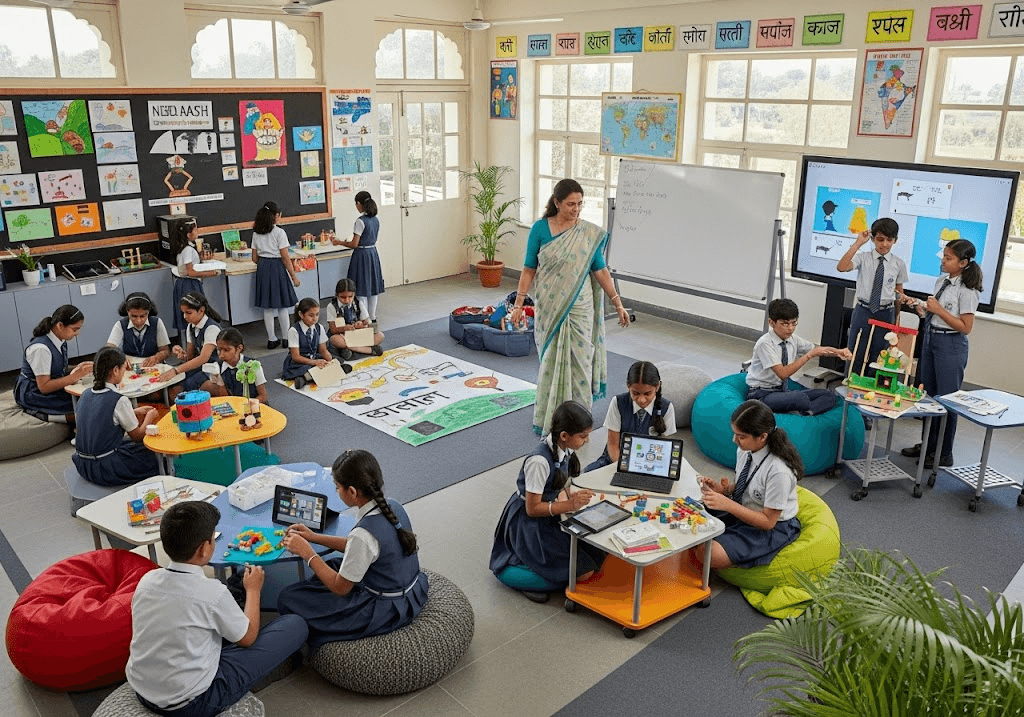How Innovative Schools in India Are Transforming Classrooms with Creative Learning
The landscape of education in India is experiencing a remarkable transformation. Traditional chalk-and-talk methods are giving way to dynamic, interactive learning environments where creativity takes center stage. Innovative schools in India are leading this educational revolution, fundamentally changing how students learn, think, and prepare for the future.
This shift aligns perfectly with the National Education Policy 2020's vision of holistic education that emphasizes critical thinking over rote memorization. Parents and students are witnessing firsthand how progressive schools in India are creating learning experiences that not only educate but truly inspire.
Breaking Free from Rote Learning: The Creative Revolution
The most significant change happening in modern classrooms is the move away from memorization-based learning. Creative learning approaches are taking precedence, transforming students from passive recipients to active participants in their educational journey.
Key changes include:
Inquiry-based learning that encourages students to ask questions and seek answers
Problem-solving activities that develop analytical thinking skills
Real-world applications that make abstract concepts tangible
Student-centered discussions that promote diverse perspectives
Hands-on experiments that bring theoretical knowledge to life
This transformation helps students develop the 21st-century skills they'll need in an increasingly complex world.
Technology Integration: Making Learning Interactive
Innovative schools in India are leveraging cutting-edge technology to create immersive learning experiences that captivate student attention and enhance understanding.
Modern classroom technology includes:
Smart interactive boards that make lessons visually engaging
Augmented Reality (AR) tools for exploring complex concepts
Virtual Reality (VR) experiences for virtual field trips
AI-powered learning platforms that adapt to individual student needs
Gamification elements that make learning fun and competitive
Digital collaboration tools for seamless group projects
These technological innovations ensure that learning becomes an exciting adventure rather than a mundane routine.
Collaborative Learning: Building Tomorrow's Team Players
Progressive education emphasizes the importance of collaboration and peer-to-peer learning. Students are encouraged to work together, share ideas, and learn from each other's experiences.
Collaborative learning strategies include:
Group projects that tackle real-world challenges
Peer tutoring programs where students help each other
Team-based competitions that foster healthy rivalry
Student-led presentations that build confidence
Cross-grade partnerships that create mentorship opportunities
This approach prepares students for future workplaces where teamwork and communication are essential.
STEAM Education: Where Creativity Meets Science
The integration of Science, Technology, Engineering, Arts, and Mathematics (STEAM) represents a revolutionary approach to creative learning. This interdisciplinary method helps students understand that knowledge areas are interconnected rather than isolated subjects.
STEAM implementation includes:
Design thinking workshops that encourage innovative solutions
Art-integrated science projects that make learning memorable
Engineering challenges using everyday materials
Mathematical modeling for real-world problems
Cross-curricular projects that blend multiple subjects
This holistic approach nurtures both analytical and creative thinking abilities.
Project-Based Learning: Bridging Theory and Practice
Progressive schools in India are increasingly adopting project-based learning models that connect classroom knowledge to practical applications. Students work on extended projects that require them to research, analyze, create, and present solutions.
Project-based learning features:
Field research that takes students beyond classroom walls
Community partnerships that provide real-world context
Long-term investigations that develop patience and persistence
Presentation skills development through regular showcases
Portfolio creation that documents learning journeys
This approach ensures that students understand not just what they're learning, but why it matters.
Flexible Learning Spaces and Personalized Approaches
The physical classroom environment plays a crucial role in fostering creative learning. Innovative schools in India are redesigning their spaces to support various learning styles and activities.
Modern learning spaces feature:
Modular furniture that can be reconfigured for different activities
Maker spaces equipped with tools for hands-on creation
Open collaboration areas for group work
Technology integration zones with easy access to devices
Outdoor learning spaces that connect with nature
Recognizing that every student learns differently, progressive education emphasizes personalized learning approaches. Teachers use data-driven insights to understand individual student needs and adapt their teaching methods accordingly through learning style assessments, adaptive software, and flexible pacing.
Teacher Training: Facilitators of Creative Learning
The success of creative learning methods depends heavily on teacher preparation and ongoing professional development. Educators are being trained to shift from traditional lecture-based teaching to facilitation-based approaches.
Teacher development focuses on:
Creative pedagogy training that introduces innovative teaching methods
Technology integration skills for effective digital tool usage
Student engagement techniques that maintain attention and interest
Collaborative teaching approaches that involve multiple educators
Well-trained teachers become the catalysts for transformative learning experiences.
As educational institutions like SSRVM Trust demonstrate, the future of Indian education lies in embracing innovation while maintaining strong academic foundations. These transformation efforts are preparing students not just for examinations, but for life itself.
The journey toward creative learning is ongoing, with exciting developments in artificial intelligence and sustainability education on the horizon. As more schools adopt these innovative approaches, Indian students will be better equipped to thrive in an interconnected, rapidly changing world.
Frequently Asked Questions
**1. What makes a school "innovative" in terms of creative learning? **
Innovative schools integrate technology, emphasize hands-on learning, encourage collaboration, and create flexible learning environments that adapt to student needs.
2. How do innovative teaching methods benefit students academically?
Creative learning approaches improve critical thinking, problem-solving skills, and student engagement while enhancing performance on both tests and real-world applications.
3. Are progressive schools in India following international standards?
Many innovative schools align with international frameworks like IB or Cambridge while maintaining relevance to Indian culture and values.
4. How can parents support creative learning at home?
Parents can encourage curiosity, provide hands-on materials, engage in educational conversations, and create spaces for creative expression.
5. What role does technology play in modern classroom transformation?
Technology enables interactive learning, personalized instruction, and virtual collaborations while being balanced with human interaction for holistic development.
6. How do innovative schools prepare students for future careers?
By developing 21st-century skills like creativity, collaboration, and critical thinking, preparing students for adaptability and lifelong learning.
7. What should parents look for when choosing an innovative school?
Look for qualified teachers, modern facilities, balanced curriculum, student-centered approaches, and alignment with your family's educational values.

